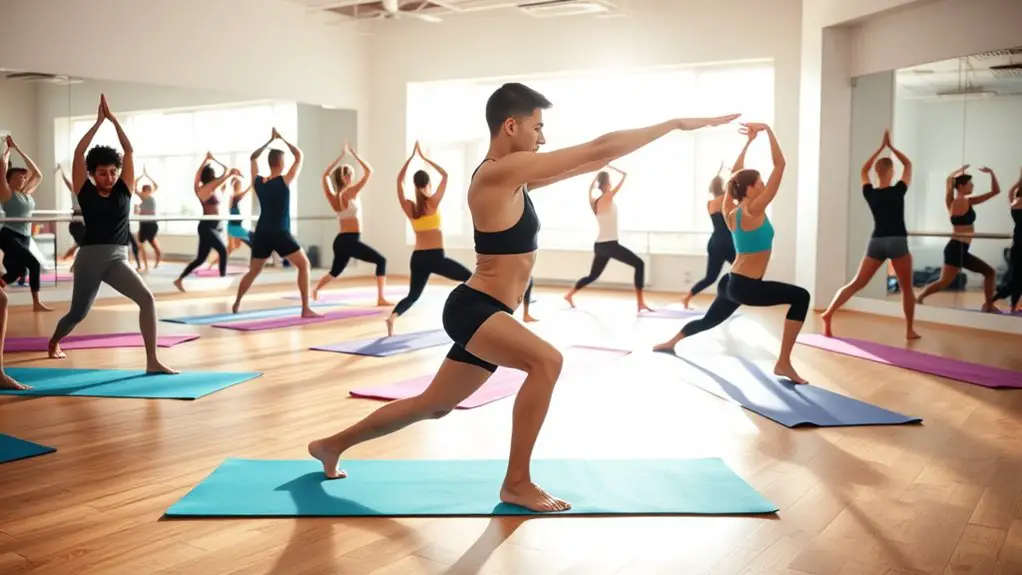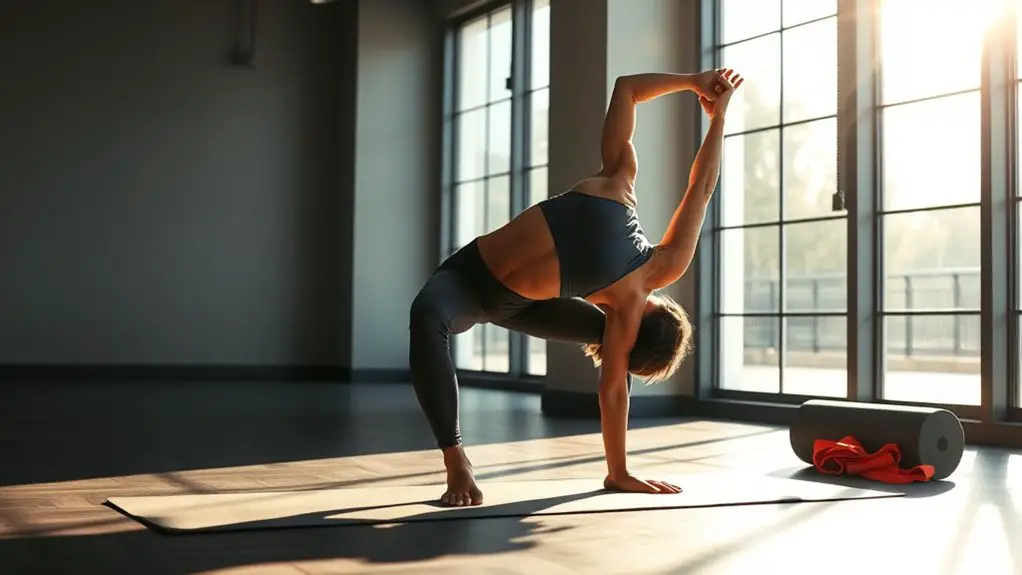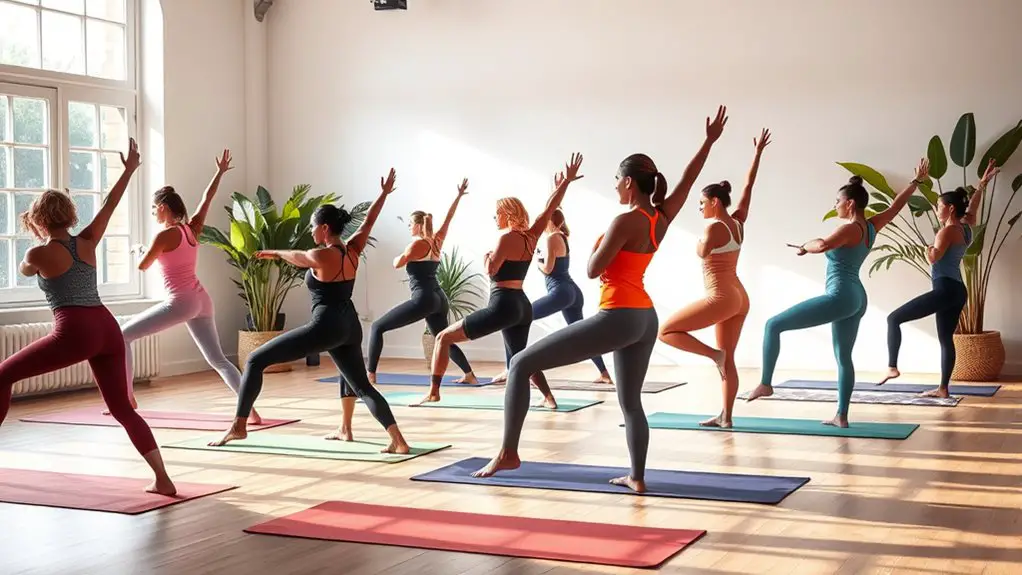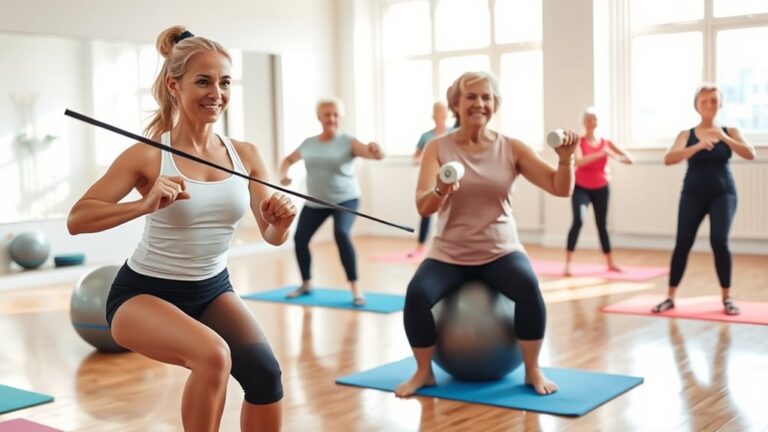How to Increase Flexibility With Gym Exercises

To increase your flexibility with gym exercises, incorporate both dynamic and static stretching into your routine. Start with dynamic stretches like leg swings and walking lunges to warm up your muscles. After your workout, focus on static stretches, holding each for 15 to 30 seconds. Don’t forget foam rolling to release muscle tension. Activities like yoga and Pilates also enhance flexibility while strength training helps improve movement control. Keep going, and you’ll discover more effective strategies to boost your flexibility.
Understanding Flexibility and Its Benefits

When you think about fitness, flexibility often gets overlooked, yet it plays an essential role in your overall well-being. Flexibility, defined as the ability of your joints and muscles to move through their full range of motion, is vital for maintaining balance and preventing injuries. Without adequate flexibility, you might find yourself more prone to strains or sprains during workouts or daily activities.
Understanding flexibility’s importance can guide your fitness journey. Improved flexibility enhances your performance in various exercises, allowing for better movement efficiency and reduced fatigue. It also aids in post-workout recovery, helping your muscles to relax and repair. By incorporating flexibility training into your routine, you’re not just boosting your physical capabilities but also promoting better posture and reducing tension.
Dynamic Stretching Exercises for Warm-Up
To effectively prepare your body for exercise, incorporating dynamic stretching into your warm-up routine is essential. Dynamic warm-ups involve active stretches that engage your muscles and joints, improving your range of motion while reducing the risk of injury. Start with leg swings, moving your legs forward and backward, gradually increasing the height. Next, try arm circles to loosen up your shoulders. Walking lunges are also great; they not only stretch your hip flexors but also activate your quads. Don’t forget high knees or butt kicks to elevate your heart rate while promoting flexibility. Aim for 5-10 minutes of these dynamic stretches before diving into your workout. By prioritizing these active stretches, you’ll guarantee your body’s ready for the demands of exercise, enhancing your performance and keeping you safe. Remember, a proper warm-up can make a significant difference in your workout experience.
Static Stretching Techniques for Improved Flexibility

After completing your dynamic warm-up, it’s time to focus on static stretching techniques that can further enhance your flexibility. Static stretching involves holding a stretch for a set period, allowing your muscles to relax and lengthen. To start, choose a comfortable position and gently ease into the stretch, avoiding any bounce or jerky movements. Aim for a static hold of 15 to 30 seconds for ideal results.
Be mindful of your body’s signals—if you feel sharp pain, ease out of the stretch. Incorporating static stretches into your routine can greatly aid in muscle recovery, reducing soreness and improving overall flexibility. Target major muscle groups like hamstrings, quadriceps, and shoulders for extensive benefits. Remember to breathe deeply while holding each stretch, as this promotes relaxation and enhances the effectiveness of the stretch. Consistency is key, so make static stretching a regular part of your fitness regimen.
Incorporating Foam Rolling Into Your Routine
Foam rolling can be a game-changer for enhancing flexibility and muscle recovery. By incorporating effective foam rolling techniques into your routine, you can alleviate tension and improve blood flow to your muscles. Start with gentle pressure and gradually increase it to find your comfort level—never force it, as that can lead to injury. Focus on key areas like your calves, quads, and back, rolling slowly over each muscle group for about 30 seconds.
The foam rolling benefits are numerous; it helps reduce soreness after workouts and enhances your range of motion. This method prepares your muscles for stretching, making subsequent exercises safer and more effective. Remember to listen to your body and avoid rolling over bony areas or joints. By consistently using foam rolling, you’ll not only feel better during workouts but also support your overall flexibility goals.
Yoga and Pilates for Enhanced Flexibility

When it comes to improving flexibility, integrating yoga and Pilates into your fitness routine can be incredibly beneficial. Both practices emphasize controlled movements and mindfulness, which not only enhance flexibility but also promote overall well-being. You’ll experience various yoga benefits, such as increased range of motion and improved posture, while Pilates techniques focus on strengthening your core and elongating muscles.
Here’s a quick comparison:
| Yoga Benefits | Pilates Techniques |
|---|---|
| Enhances balance | Strengthens core muscles |
| Increases joint flexibility | Improves muscle alignment |
| Reduces stress levels | Promotes controlled breathing |
Strength Training Movements That Promote Flexibility
Incorporating strength training into your routine can complement the flexibility gains you’ve achieved through yoga and Pilates. Focus on movements that engage multiple muscle groups while promoting a full range of motion. Exercises like squats, lunges, and deadlifts not only build strength but also enhance flexibility in your hips and hamstrings.
Incorporate resistance bands or lighter weights to guarantee you’re maintaining control throughout each movement. Remember to prioritize proper form to prevent injuries. As you perform these strength training exercises, pay attention to your body’s signals, allowing adequate time for muscle recovery. This will help prevent stiffness and keep you limber.
Additionally, don’t forget to integrate dynamic stretches before your workouts and static stretches afterward. This combination will help support your flexibility goals while guaranteeing a balanced approach to strength training. By doing so, you’ll create a well-rounded fitness routine that nurtures both strength and flexibility.
Tips for Consistency and Progress Tracking
To stay consistent with your flexibility training, it’s essential to create a structured routine that fits seamlessly into your lifestyle. Start by setting clear and achievable goals. Whether you aim to touch your toes or perform a full split, having specific targets helps keep you motivated.
Next, maintain a progress log. Documenting your flexibility exercises and improvements not only helps you stay accountable but also lets you see how far you’ve come. Record your stretches, hold times, and any changes in your range of motion.
Make sure to schedule your flexibility sessions at times when you’re least likely to skip them. Consistency is key, and even short daily sessions can yield significant results over time. Finally, listen to your body; don’t push too hard, as safety is paramount in your journey to increased flexibility.
Frequently Asked Questions
How Often Should I Stretch to See Results?
How often should you stretch to see results? It really depends on your goals! Ideally, you should incorporate dynamic stretching before workouts and static stretching afterward, aiming for at least three times a week. This way, you’ll keep your muscles safe and improve flexibility over time. Remember, consistency is key! If you’re not feeling any progress, don’t hesitate to adjust your routine or consult a professional for guidance.
Can Flexibility Improve My Athletic Performance?
Absolutely, flexibility can greatly improve your athletic performance. When you incorporate flexibility benefits into your athletic training, you enhance your range of motion, reduce the risk of injury, and increase overall efficiency in movements. This means you can run faster, jump higher, and perform better in your sport. Just remember to stretch safely and listen to your body—pushing too far can lead to strains. Consistent, gentle stretching is key to reaping these benefits.
What Are Common Mistakes in Stretching?
When it comes to stretching, you might be making common mistakes that could hinder your progress. For instance, static stretching before a workout can lead to injury if your muscles aren’t warmed up. Instead, consider dynamic stretching to prepare your body. Also, don’t rush through stretches; holding each position for the recommended time is essential. Finally, listen to your body and avoid pushing past your comfort zone to guarantee safety.
Is It Possible to Be Too Flexible?
Imagine a rubber band stretched too far; it loses its strength. Similarly, it’s possible to be too flexible. When you push your flexibility limits beyond what’s safe, you increase your injury risks. Staying within a healthy range guarantees your body remains strong and resilient. Balance is key, so listen to your body and don’t chase extreme flexibility. Remember, it’s about strength and stability, not just how far you can bend or stretch.
How Does Hydration Affect Flexibility?
Hydration plays an essential role in maintaining your flexibility. When you’re well-hydrated, your muscles and joints function more effectively, reducing the risk of injury. Proper water intake helps keep your connective tissues lubricated, allowing for smoother movements. Plus, staying hydrated can enhance your overall performance and recovery. So, make sure you’re drinking enough water throughout the day to reap these hydration benefits and support your body’s flexibility safely.





